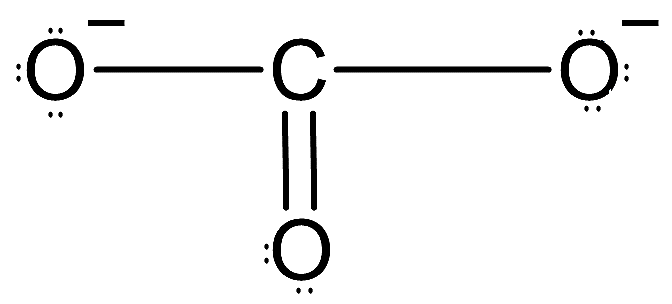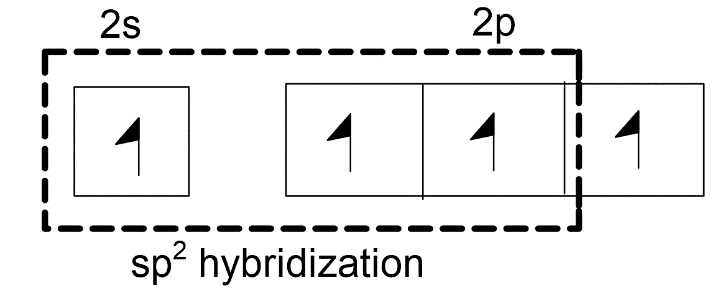
Explain hybridization of central atom in: $CO_{3}^{2-}$
Answer
575.7k+ views
Hint: Think which atom is the central atom in the given ion. Write the electronic configuration of both carbon and oxygen atoms. Find out the total number of electron pairs present in the system and accordingly figure out the hybridization.
Complete answer:
- Let’s start by counting the number of electron pairs present in the system.
- Carbon has atomic number 6 and oxygen has atomic number 8.
\[C=1{{s}^{2}}2{{s}^{2}}2{{p}^{2}}\]
\[O=1{{s}^{2}}2{{s}^{2}}2{{p}^{4}}\]
- Number of valence electrons in carbon is 4 and in oxygen is 6.
- Carbonate ion has one carbon atom, three oxygen atoms and -2 charge.
- Therefore, the total number of electrons present in carbonate ion $=4+\left( 3\times 6 \right)+2=24$.
- Therefore, the total number of electron pairs present is $\dfrac{24}{2}=12$.
-So, the Lewis dot structure of $CO_{3}^{2-}$ can be drawn as follows:

-Here, carbon is the central atom and we can see all twelve electron pairs are present and charge of the ion is also -2. Now, carbon is forming a double bond. We know that doubly bonded carbon is always $s{{p}^{2}}$ hybridized.

-One 1s orbital and two 2p orbitals will combine to form three $s{{p}^{2}}$ hybridized orbitals. One unhybridized 2p orbital of carbon will laterally overlap with one unhybridized 2p orbital of oxygen to form pi-bond. Thus, there is a presence of one double bond in the carbonate ion.
- Therefore, the carbon atom in carbonate ion, $CO_{3}^{2-}$ is $s{{p}^{2}}$ hybridized.
Note:
In this type of problems, start by writing electronic configuration and then calculating the total number of electron pairs and then, try drawing the structure to get an accurate answer. Carbonyl ion has trigonal planar geometry.
Complete answer:
- Let’s start by counting the number of electron pairs present in the system.
- Carbon has atomic number 6 and oxygen has atomic number 8.
\[C=1{{s}^{2}}2{{s}^{2}}2{{p}^{2}}\]
\[O=1{{s}^{2}}2{{s}^{2}}2{{p}^{4}}\]
- Number of valence electrons in carbon is 4 and in oxygen is 6.
- Carbonate ion has one carbon atom, three oxygen atoms and -2 charge.
- Therefore, the total number of electrons present in carbonate ion $=4+\left( 3\times 6 \right)+2=24$.
- Therefore, the total number of electron pairs present is $\dfrac{24}{2}=12$.
-So, the Lewis dot structure of $CO_{3}^{2-}$ can be drawn as follows:

-Here, carbon is the central atom and we can see all twelve electron pairs are present and charge of the ion is also -2. Now, carbon is forming a double bond. We know that doubly bonded carbon is always $s{{p}^{2}}$ hybridized.

-One 1s orbital and two 2p orbitals will combine to form three $s{{p}^{2}}$ hybridized orbitals. One unhybridized 2p orbital of carbon will laterally overlap with one unhybridized 2p orbital of oxygen to form pi-bond. Thus, there is a presence of one double bond in the carbonate ion.
- Therefore, the carbon atom in carbonate ion, $CO_{3}^{2-}$ is $s{{p}^{2}}$ hybridized.
Note:
In this type of problems, start by writing electronic configuration and then calculating the total number of electron pairs and then, try drawing the structure to get an accurate answer. Carbonyl ion has trigonal planar geometry.
Recently Updated Pages
Why are manures considered better than fertilizers class 11 biology CBSE

Find the coordinates of the midpoint of the line segment class 11 maths CBSE

Distinguish between static friction limiting friction class 11 physics CBSE

The Chairman of the constituent Assembly was A Jawaharlal class 11 social science CBSE

The first National Commission on Labour NCL submitted class 11 social science CBSE

Number of all subshell of n + l 7 is A 4 B 5 C 6 D class 11 chemistry CBSE

Trending doubts
What is meant by exothermic and endothermic reactions class 11 chemistry CBSE

10 examples of friction in our daily life

One Metric ton is equal to kg A 10000 B 1000 C 100 class 11 physics CBSE

1 Quintal is equal to a 110 kg b 10 kg c 100kg d 1000 class 11 physics CBSE

Difference Between Prokaryotic Cells and Eukaryotic Cells

What are Quantum numbers Explain the quantum number class 11 chemistry CBSE




